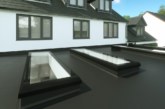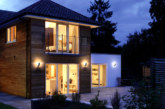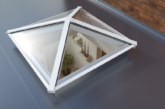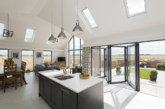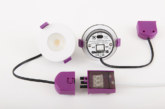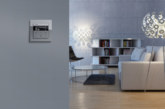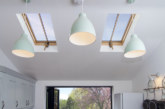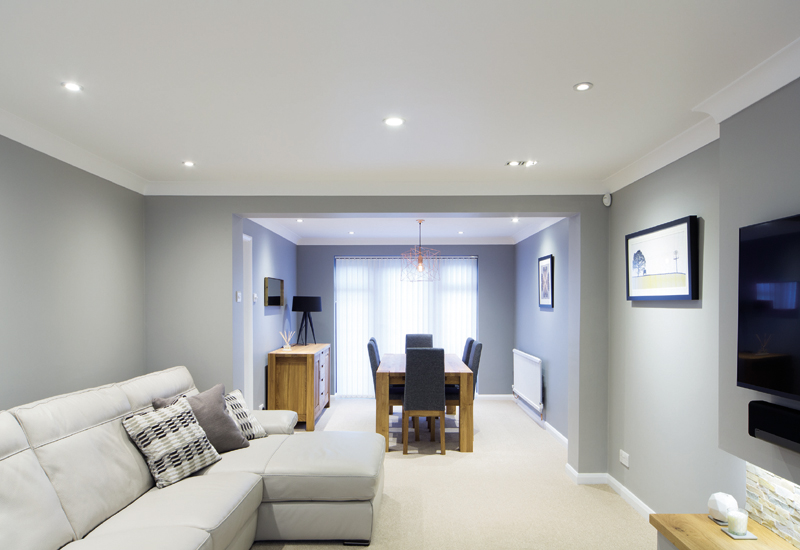
Stephen Hurrell, Divisional Director, Aurora Group UK Projects, examines why LED lighting is a must for new homes and provides some advice on how to make the most of it.
According to the Energy Savings Trust, LED offers the best value for money in lighting today; the price of fittings has come down and, at the same time, performance has improved significantly.
The Carbon Trust, of which Aurora is an accredited supplier, advocates LED as its number one efficiency recommendation, and leading website www.environmentalleader.com reports that while switching to LEDs creates a one-time savings event – typically reducing lighting energy use by up to 50% – integrated sensing and controls can nearly double those energy savings, making controls essential for maximum savings and project economics.
LED also significantly contributes to the BREEAM rating of a building as it typically halves energy consumption of traditional light sources. Miniaturisation has also led to a significant reduction in raw materials utilised in manufacture.
Lighting Performance
The four key criteria governing LED performance are thermal management, optical control, efficacy of light and reliability of power. So, what are the guiding principles of best practice in quality manufacturing?
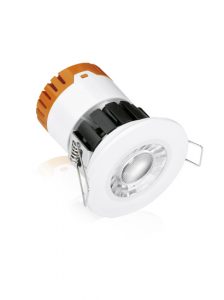 Heat has a negative impact on any LED light source’s performance. The next generation in thermal management dissipates heat away from the LED chip, providing higher quality, brighter light for longer. There’s also been continuous improvement in efficacies of LED chips so the higher the lumens per watt, the better.
Heat has a negative impact on any LED light source’s performance. The next generation in thermal management dissipates heat away from the LED chip, providing higher quality, brighter light for longer. There’s also been continuous improvement in efficacies of LED chips so the higher the lumens per watt, the better.
Look for products warranted to L70 to a stated number of hours. This means you can expect a light output of 70% of the lumen performance stated at that period of time e.g., a 1000 lumen LED luminaire will deliver at least 700 lumens after six years, based on burning 4000 hours per year.
An emerging trend in construction is to insulate the ceiling void by ‘blowing in’ loose fill insulation as an alternative to loose-laid products. Loose fill completely encloses the fitting, which could affect LED performance in inferior downlights.
While Europe prepares to ban Class D halogen lamps, the lighting industry has responded by developing lamps that produce low glare while providing sparkling halogen-like appearance for both new and retrofit solutions.
Regulatory compliance
Lighting design is a complex issue and part of a quality manufacturer’s role is to offer specifiers and installers technical support so they can comply with regulations. As part of the Aurora Lighting Group, Enlite’s V5 catalogue offers at-a-glance lighting design guidance including a lux ready reckoner, a design criteria for LED products, advice on dimming compatibility and a summary of L1 & L2 Building Regulations.
Effective space lighting
Artificial lighting in buildings is usually categorised in three ways. The ‘Ambient’ lighting function provides light to the space to an accepted level. ‘Accent’ lighting highlights certain features and/or attributes. ‘Task’ lighting illuminates specific working areas to aid visibility. To give some examples of best practice, we’ve looked at some ways of lighting the ground floor and exterior of a property.
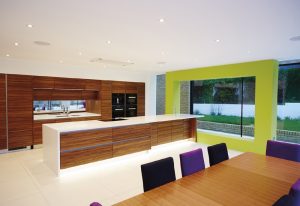 The kitchen area will require all three categories and lighting design should always start with the ‘Ambient’ component. This usually means LED downlights recessed into the ceiling to provide a level of illumination across the space.
The kitchen area will require all three categories and lighting design should always start with the ‘Ambient’ component. This usually means LED downlights recessed into the ceiling to provide a level of illumination across the space.
To add accent and ambience, consider low level strip lighting or recessed floor lights around the plinths of the kitchen units. High level strip lighting on top of the kitchen units can be used to illuminate the ceiling and based spot lighting will illuminate cupboards or free-standing furniture. Internal lighting within glass-fronted units creates aesthetic focus.
‘Task’ lighting usually takes two forms. Strip lighting or spotlights under the wall cupboards are used to illuminate the worktops; and either suspended or recessed fittings over central islands or the breakfast bar will illuminate the job in hand.
The dining area often needs to serve a multipurpose function; eating, working at home or maybe educational study. Again, start with ‘Ambient’ lighting to provide a cohesive fit with the kitchen and ‘Accent’ lighting can illuminate display cabinets and bookcases. Task lighting could comprise ceiling- recessed lighting over the dining table or simply a well-positioned reading lamp.
Living room space is multi-use for relaxing, watching television as well as social entertaining. The single pendant is best replaced with recessed dimmable downlights, supplemented by ambient floor and/or table lamps for task lighting such as reading.
Lighting the kitchen/dining space
The kitchen/dining area will require all three categories of ambient, accent and task lighting. Here is a suggestion for a specification:
- Ambient: Enlite’s award-winning ICE lamps feature edge-to-edge multifaceted, sculptured Enfiniti lenses which produce low glare while providing a sparkling halogen-like appearance.
- Accent: Enlite’s E8 8W LED fixed/adjustable fire rated downlights highlight a room’s special features.
- Task: Enlite’s 12V single colour, 5m cuttable LED StripKit is one of three in the range and can be used for task lighting without the need for soldering.
External lighting
Lighting in gardens is regarded as a must-have in order to enjoy outdoor areas after dusk. Hours of darkness also provide an almost theatrical setting in which to display homes to great effect.
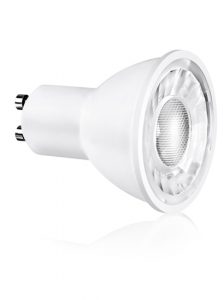 However, artificial lighting must work in harmony with both segments. In this context, less is more so aim to create a lighting balance between the internal environment, the external patio or decking area and within the wider garden area.
However, artificial lighting must work in harmony with both segments. In this context, less is more so aim to create a lighting balance between the internal environment, the external patio or decking area and within the wider garden area.
Start with ambient lighting and consider first what internal lighting is helping to illuminate the exterior patio or decking area. Then provide additional lighting to complement rather than just floodlight the area. Wall lighting can provide an ideal solution, however where bi-folding doors are installed, the lack of wall space may require the use of some soffit-based downlight or very small floodlights.
Consider creating a boundary around the space, using LED in-ground up-lighting, which can be either white or blue in colour and being flush will not create a hazard for persons within the space. These fittings are small, energy efficient and require no maintenance for many years to come when installed correctly. Small post lighting may offer an alternative solution for patios and decking areas as they too will provide a boundary to the space.
Safe access and security need to be considered so that lighting provides an illuminated route from the patio or decking area through the garden and further expands the use of external space available. Lighting within the wider garden also needs to be of consideration as it can provide a backdrop and offer an appealing visual effect.
Visit http://enlitelighting.com


